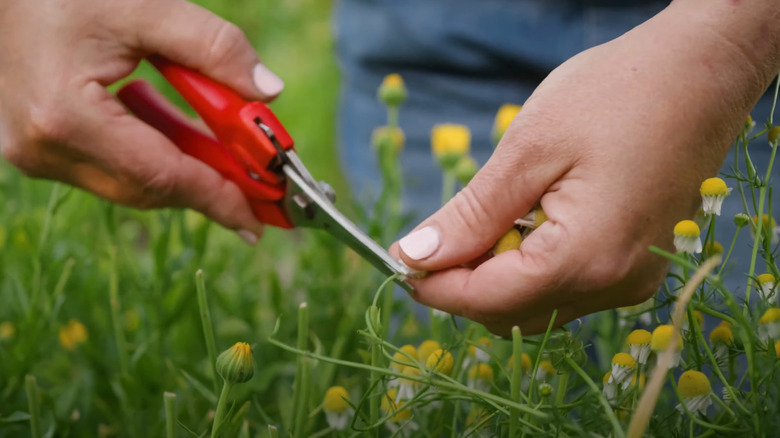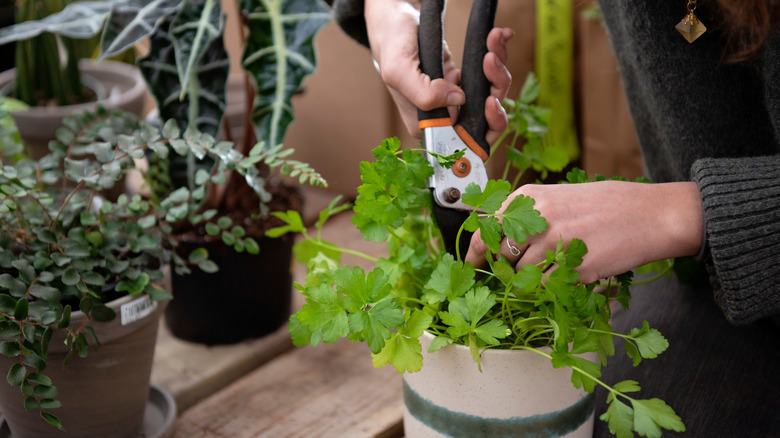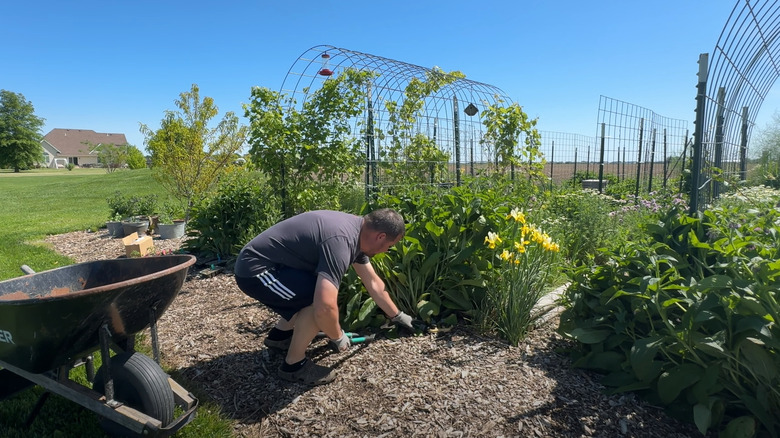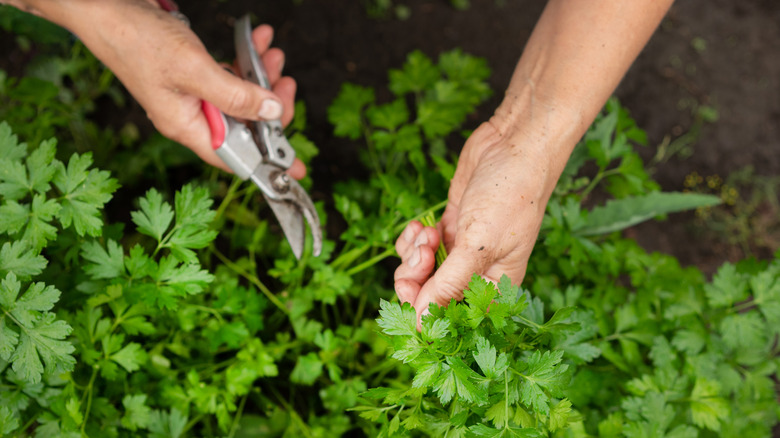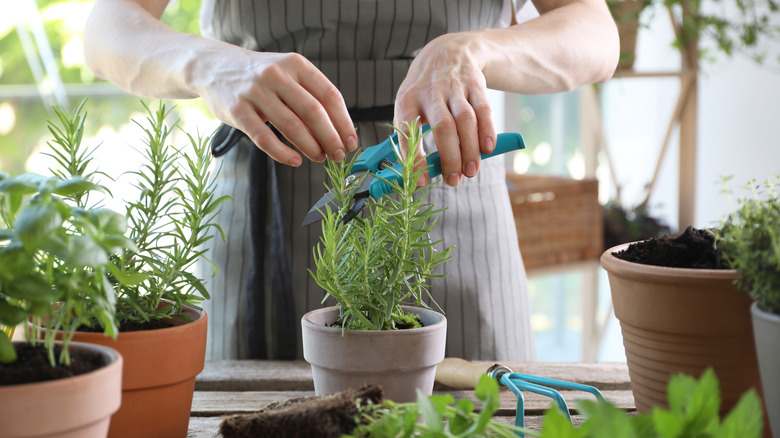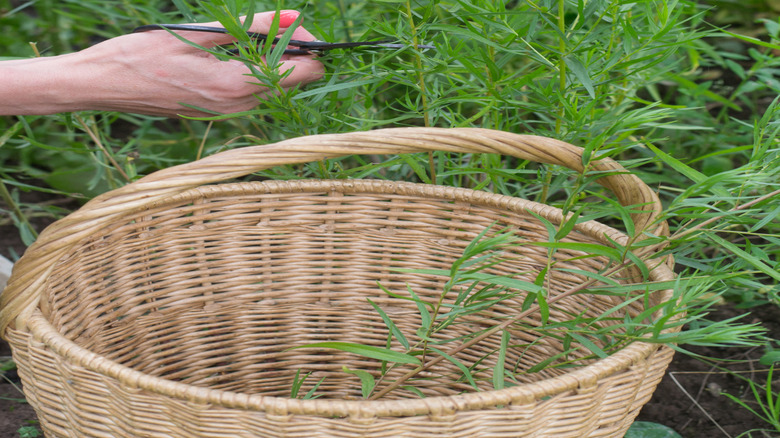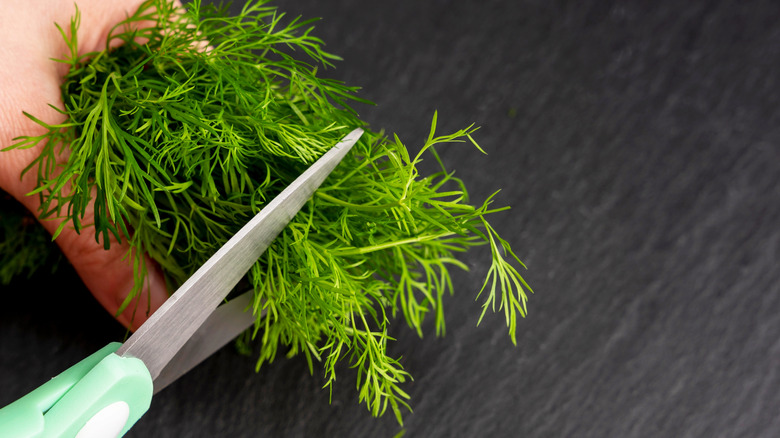9 Herbs That Need Pruning To Thrive (And The Best Times To Do It)
We may receive a commission on purchases made from links.
Growing herbs from seeds or cuttings requires careful handiwork. You have to get the soil, fertilizer, lighting, and watering just right. In some cases, routine pruning, cutting, and harvesting are also essential for maintaining a healthy herb garden.
Avoid one of the biggest mistakes people make when growing herbs by knowing when to cut back several popular species. Pruning benefits many of these plants by encouraging healthier growth, ensuring a longer production period, and even putting out better-tasting produce. A thriving plant in optimal condition creates more robust foliage, giving indoor or outdoor gardens a better life while providing their cultivators with better harvests. It's a win-win situation as long as you know what you're doing. So, learn why pruning is necessary, when to do it, and how to do it properly.
Snip off basil buds before they bloom
Pruning a basil plant is key to maximum yield, and when these plants start growing small buds, they should be snipped before they bloom and turn into full-fledged flowers. When flowers are allowed to form, basil plants prioritize them instead of their leaf growth. Then, the stems become more woody and dry out, resulting in fewer leaves with a bitter taste. Even when flowers aren't present, basil should be pruned once it reaches about six to eight inches tall to prevent it from becoming overgrown.
The exact timing that the plant flowers may vary depending on your local climate, so keep an eye on basil plants when temperatures start rising. At the first sight of buds, wash your hands and pinch them off with your fingertips. Your fingers are a good enough tool for removing individual and sparse buds. However, if there are numerous buds to take care of and the stems need trimming too, use a snipping tool like Fiskars Herb Garden Scissors. Make sure to cut the stems at the node to encourage fuller growth. Don't trim back more than one-third of these plants, and prune them every two to three weeks, or as they start looking leggy.
Prune unused chamomile blossoms to make room for more edible flowers
Chamomile is an herb that naturally enriches and improves garden soil as long as it's healthy. One of the most important steps in growing chamomile is deadheading it with a pair of gardening snips to encourage flower growth. These plants should also be cut back to keep them from growing too tall and leggy, and to encourage a fuller shape. The only chamomile variety that doesn't need these treatments is the Treneague, which is non-flowering and keeps to a low height.
Healthy chamomile flourishes throughout the growing season of spring and summer. You may have to deadhead the blossoms and trim them down multiple times. There isn't an exact science to it. Keep an eye on the herb garden, and observe when stems start growing too tall with few flowers. Cut them back to about four or five inches around the middle of the growing season to maintain a bush-like shape.
Pinch young cilantro flowers before they blossom
Like basil, cilantro herbs need regular pruning to keep them healthy and happy. Pinch back young cilantro flower buds before they open to preserve the look and taste of the leafy foliage. If the plant is allowed to bolt, the leaves will lose their flavor, and the plant will eventually die.
Warm temperatures are the main cause behind bolting, which makes summer a difficult time to grow cilantro. For this reason, it's an ideal herb to grow in the spring and fall. Another popular method is to practice successive planting. Some herb gardeners plant every two to four weeks, pruning, harvesting, and planting new cilantro on a regular basis. The routine makes it easy to keep an eye on them, so they can be cut back as needed, even when temperatures are exceptionally high. On that note, these plants are good to cut for harvest once they reach a height of six inches.
Cut back comfrey to promote healthier future growth
Comfrey plants are an uncommon choice for kitchen herb gardens, since they have invasive qualities and are toxic when ingested. This herb is primarily grown for ornamental reasons and weed control, making it important to prune it properly and maintain its aesthetics. You must prune back this plant to keep it from overtaking your property. When properly maintained, this perennial herb is a great garden asset that suppresses other weeds and improves soil conditions.
Cut comfrey down to a few inches tall after its first growing season to encourage new growth. Keep in mind that only the second year of growth should be harvested and dried. This can be done every two weeks, and don't worry about overdoing it. You can even harvest the roots during the growing season, and it should survive.
Remove oregano flowers to ensure the plant prioritizes leaf growth
Oregano is another herb that requires pruning to maintain healthy leaves. Keeping it trimmed stops the plant from growing too leggy. Long and thin stems create a weak foundation to support themselves, creating an overall more feeble plant. Removing dead and dying growth also allows oregano to focus on producing new, fresh leaves.
Start by identifying the oregano's primary stem and the smaller branching stems. Cut the branching stems just above the leaf nodes to encourage new growth closer to the central stem. The whole plant can be trimmed down to about half its length, and you can do so as needed throughout the growing season. Be especially diligent toward the end of the season when buds form, which will turn into clusters of tiny pink, purple, and white flowers. Oregano plants then focus on the flowers instead of the foliage, affecting the quality of their edible leaves.
Parsley blooms must be trimmed off to preserve the leaves for food
When growing and caring for your own parsley herb, pruning is an important step. Many gardeners treat this biennial herb as an annual. It grows and produces fresh parsley leaves during its first season, and depending on the variety, blooms with green and yellow flowers during its second season. The leaves are not as plentiful and flavorful once flowers appear, so the prime time to cut and harvest is during the first year. Keeping up with routine cutting prevents parsley from growing too tall and weak. When left uncut and overgrown, the lower leaves turn yellow and wilt.
Cut stalks with young leaves down a half-inch so they produce more foliage. Also, prune as needed to keep them from taking over other plants in a herb garden while encouraging bushier growth. Sarah Rubens, owner of Seeds to Sanctuary, told The Spruce, "The best time to prune parsley is once the plant has become established and is producing several stems — typically a few weeks after planting." Just make sure to use clean scissors or shears when cutting the plant.
Prune rosemary to keep its growth dense and lush
Rosemary is known to be a slow grower from seed. For this reason, many gardeners cut it for propagation and to encourage bushier growth in already-established plants. Pruning is a good solution if a plant starts looking bare, as woody stalks don't make new growth. So, remove these so healthy rosemary plants can grow back with more spring-like foliage.
Only cut up to one-third of the rosemary's top growth at a time. You can do so during the late spring and early summer, at the start of the growing season. This gives these herbs time to grow strong and healthy foliage before winter comes. Refrain from pruning once fall arrives, or you'll risk losing rosemary to winter exposure. You should also know how and when to harvest rosemary stalks. If you're cutting plants for the harvest, not just for the plant's health, do so early in the day. The best quality rosemary is picked just after the morning dew dries.
Keep tarragon healthy with diligent pruning
Tarragon is another herb that flourishes with pruning assistance. Deadhead flower buds to encourage the stems and leaves to form healthier growth. Maintain tarragon at a medium height, since these plants can fall over when they grow too tall. Wet weather can also cause these herbs to decline. If so, prune the affected leaves to make room for the herbs to thrive with new growth instead.
Tarragon can be cut all the way down to the ground in early spring. Otherwise, they should be pruned regularly throughout the mid to late summer, especially during heavy rains that impede their health. Don't let these herbs grow above two feet, which is the general cutoff for when they become too high to support themselves. The individual leaves can also be plucked throughout most of the growing season, from late spring to early fall using your fingers or garden shears.
Cut dill to prevent flowering and keep the herb alive
When dill is allowed to flower and go to seed, it perishes. Therefore, it's important to get the most out of your plant while it's alive and putting out new leaf growth. Make sure you prune it regularly, which encourages newer, healthier, and more robust growth from the center stem. Also, pinch off any buds as they appear, putting off the flowering for as long as possible. Once the flowering begins, a dill's life and its potential harvests are on the downslope.
Like most other herbs, there are no precise directions and timeframes for cutting. Aim for the outermost stems when snipping so new growth occurs on the more interior ones. However, you don't want to prune more than one-third of the foliage off. Watch for flower buds around midsummer, so you can pluck them promptly before they open with tiny clusters of yellow petals. The safest approach is with scissors or herb snips, which ensure clean cuts on the stems.

